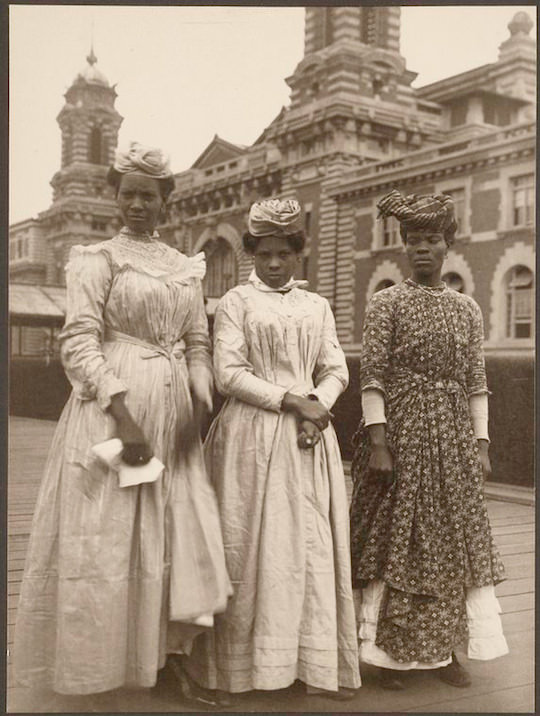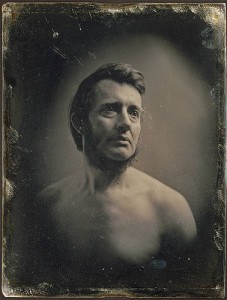
Guadalupe women, c.1905; photo made by Augustus Sherman, Chief Registry Clerk, Ellis Island; courtesy New York Public Library
A slightly belated happy new school year, it’s time for lessons and another Tips post !
There is great access to the thousands of images produced by the United States Government, and I will touch on a few of the newer ones. I also have some updates related to my series on Photographers Working in the South, a few fun free sites worth perusing, and an unexpected image to show you that was sent to me by a reader.
The interesting photograph above of three women immigrants is from a set of images made of Ellis Island Immigrants by Augustus Sherman (1865-1925) who worked at Ellis Island from 1892 – 1925 as Chief Registry Clerk. A selection of those photographs, and more information is available on one of my favorite sites I have probably mentioned before – the Public Domain Review. The site links to high-resolution images from various sources worldwide. Most of these images, of course, are in the public domain. See their “About” page for their image sources, and for their useful links to repositories around the world.
Another of my favorite image groups on the PDR site is called Beards of Time, which inspired me to use Five Bearded Men from my own collection of photographs, for a Wordless Wednesday post. An image used in the PDR bearded men group is none other than pioneer photograph Albert Southworth, partner to Josiah Johnson Hawes in Southworth & Hawes daguerreotype studio, in Boston 1843 -1863.

Albert Sands Southworth, daguerreotype by Southworth & Hawes, ca. 1848; George Eastman House Collection, accession number 1974:0193:1129
To look at all the various image sets on the PDR home page, simply click “Images” under the drop down menu for “Collections” near the top of the site. There is also a search box if you hope to find a particular topic.
Speaking of images produced by U.S. government agencies, a new site, the Open Parks Network was recently announced by Clemson University and the National Park Service. It is a “digital gallery of rare and unique material from the archives of the country’s national parks, historic sites and battlefields.” Images predating the establishment of the park, historic sites or battlefield are also included, and there are drawings and plans, and images which include individuals or groups.
For Georgians, the many images and plans of Fort Frederica National Monument and Historic Site, and of the Andersonville National Historic Site and the P.O.W. Museum, are especially interesting.
Another set of images from the Open Parks Network was highlighted in a Smithsonian magazine article. My father-in-law was a member of The Civilian Conservation Corps in California in the 1930s. As part of Roosevelt’s New Deal, many young men of the Depression were given jobs, food and lodging, and pay, in exchange for work. Many of these men, like my father-in-law, sent the money they earned to their parents, or other family.

CCC member in work clothes (Open Parks Network, Creative Commons / Public Domain)
The CCC made our national parks into what they are today. Most of the images used in the magazine article are of those Corps members who worked on structures and grounds at Mammoth Cave National Park in Kentucky.
Speaking of The Great Depression, the Library of Congress has a set of FSA/OWA images in color. These Color photographs, shot with Kodachrome color film, are the focus of a book, New Deal Photography: USA 1935-1943, published by Taschen. This link to an article about the book has a great selection of those color photos, including one from Green County, Georgia. But you can also look at more of these wonderful color photos, including others shot in Georgia, on the Library of Congress Flickr site.
Another site I recently learned of is Uncle Sam’s Photos which is (supposedly) a directory to the free photo collections of the U.S. Government. Unfortunately, the site is a bit of a hit or miss, with some very dead links, and you may see a few advertisements. But some links do work, and can prove useful, and the may be to places you may otherwise never think to look – such as this collection of newer photos from the U.S. Air Force.
In addition the the PDR mentioned above, another Free to peruse site is The Ultimate History Project which “promotes high-quality, cutting-edge historical scholarship intended for everyone.” Articles are written by historians who are curators, professors, independent historians, genealogists, and collectors.
There is a wealth of interesting material here – recent articles are on Ice cream and Immigrants (think of Leopold’s in Savannah, begun by Greek Americans), the Evolution of Charity in America, and Overall Clubs. A post World War I protest to the rising cost of clothing, The Overall Clubs began in Alabama and quickly spread to other states. This information makes me re-think what was behind some of the photographs I have seen!

Opera singer Sophie Braslau, ca. 1910- 1915, published by Bain News Service; Library of Congress Prints and Photographs Division George Grantham Bain Collection http://www.loc.gov/pictures/item/ggb2005012412/
Pinterest is another place to check, in addition to Flickr, for Library of Congress and other U.S. government photos, as well as other useful photography sites. Among others, I keep two “boards” on my Pinterest site related to photography. One is the Photo History Toolbox to which I recently added “Beauty Standards in Turn-of-the-Century Photographs” which links to an article from Mental Floss. The image of Sophie Braslau, from the Library of Congress via Flickr, is used in that article.
On this board I pin links to information on photo identification, preservation, film and cameras, scanning, links to lists of photographers, rights and reproduction, photography in other countries, and links to some of my posts about photography, among other things.
The other fun-for-me photo-related board that I pin to is Photographers! and Photo Friends where I pin photographs or other images of persons (or others) taking photographs. Some of these people are famous, some unknown. You will see here many cameras, books about photography and photographers, film and motion picture operators, etc. I am also (too, too) slowly pinning my own posts to a board called Blogging Georgia Photographers.
In the Updates department: I have added only a few things to my Early Georgia Photographers, 1841 – 1861: a Biographical Checklist and those items are now highlighted in Blue. Some dates for G. A. Jeffers have been refined, as have the dates for C. J. Quinby’s work with him. See both of their entries. There has been an update to the later dates of A.J. Riddle, as well, so see his entry for reference to his work in Columbus in the 1880s. I add later dates to the entries of significant photographers, and those who worked in Georgia for many years whose work spans the decades.
Of course, this Checklist of Georgia photographers is related to my Photographers Working in the South (PWITS) series. Two new-to-me items are worth noting in this category. The first is the Newly Digitized Collections on ExploreUK – those new images are also available on the Kentucky Digital Library, which was previously highlighted in my PWITS series.
New on the ExporeUK site are The Calvert McCann photographs, 1961-1964, documenting the Civil Rights Movement in Lexington and Frankfort, Kentucky, photos of a train wreck in Richmond, Kentucky, on March 31, 1910, photographs of steamboats along the Ohio River, 1905-23, the Carolyn Murray-Wooley color transparencies collection documenting stone houses and fences built by local craftsmen, and several collections of family photographs.
We have looked at the UNC University Library’s digital collections before, but material is always begin added, so it is good to look at it from time to time. I recently did a search on the word “Georgia” for photographs. I did not come up with many unfamiliar hits, but those hits are certainly worth checking out.

“Building up an Underwood Patent Extension Stereograph Cabinet, in a home Library” [recto]; Carl Sandburg’s Collection of Stereographs, Carl Sandburg Home National Historic Site carl_stereo106247_0075a http://purl.clemson.edu/7B30D730AC274D4D6AE613AF91BA3C9C
And in closing, I heard from a reader not long ago, who had more information for me about the boy in a photograph I posted a few years ago in a Friday Faces – Boys at the Photographer’s Studio.

Detail, carte de visite of Charles Baner Bussell made by D. J. Ryan, Savannah, GA, 1869; collection of E. Lee Eltzroth
That photo is of little Charles Baner Bussell, who visited the photography studio of Savannah’s D. J. Ryan in February 1869. This boy is the same person she says “was born in New York in 1864, and died in 1938 in Seattle.”
“Charles B. became a millionnaire in the Seattle area by buying land and later selling to to people who wanted to settle there.” Do you think this boy and the man he became changed much? The deep set eyes seem the same, although they seem lighter in the photo of the boy, but they probably darkened as he grew older. One thing is certain, we can see that same receding hairline!

Charles Baner Bussell, ca. 1925- 1930, by an unknown photographer; courtesy of Shannon Alwaise
I hope a few things in this post made it worth your while to go back to school with me. Until our next time together, enjoy your autumn hunting and gathering – be it nuts, berries, pumpkins, or research.
© E. Lee Eltzroth and Hunting & Gathering, 2016. Unauthorized use and/or duplication of this material without written permission from this blog’s author is prohibited. The piece can be re-blogged, and excerpts and links may be used, provided that full and clear credit is given to E. Lee Eltzroth and Hunting & Gathering, with appropriate and specific direction to the original content.